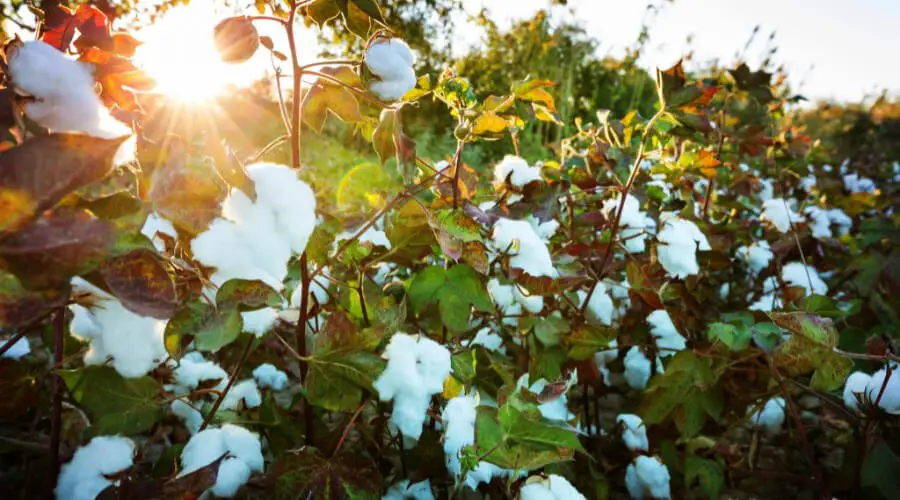Last Updated on July 23, 2023 By Emma W. Thomas
In most cases, it is not illegal to grow cotton in your garden for personal use. However, in places where cotton is a cash crop, it is illegal to grow it in your yard. In the boll weevil eradication zones, there is fear that a homeowner could create a conducive breeding environment for these pests leading to an infestation.
What States Outlaw Recreational Cotton Growing?
- North Carolina
- South Carolina
- New Mexico
- Mississippi
- Tennessee
- California
- Oklahoma
- Arkansas
- Alabama
- Louisiana
- Missouri
- Virginia
- Arizona
- Georgia
- Florida
- Kansas
- Texas
Why Is It Illegal To Grow Cotton In Your Backyard?

In most states in the US, cotton growing in the garden is not permitted. Since cotton is a cash crop that boosts the economy of different States, it needs to grow without boll weevils. As a measure to control this devastating pest, it is illegal to grow cotton for fun in your backyard.
Cotton producers have collaborated closely to reduce the threat of boll weevils, leading to the eradication of the pest in most states. According to the Boll Weevil Eradication Foundation, the efforts by cotton producers have led to the extermination of the problem.
Commercial cotton grows in heavily monitored zones to keep the boll weevil at bay, and growing it in the backyard may pose a risk of re-infestation. For this reason, it is illegal to grow cotton on a small scale for fun.
How Can You Control Boll Weevils?
Boll weevils can wreak havoc on cotton crops, causing significant economic losses for farmers. These destructive pests can quickly multiply and destroy entire crops if left uncontrolled. Fortunately, there are several strategies you can employ to manage boll weevils and minimize their impact. Here are seven effective ways to control boll weevils and protect your cotton fields:
- Plant Early-Maturing Varieties:
By planting early-maturing cotton varieties, you can reduce the period during which boll weevils can infest your crop. Early maturation allows the cotton to reach the desired yield before the weevils can cause extensive damage. - Monitor and Scout Regularly:
Regular monitoring and scouting for boll weevils are crucial for early pest detection. Systematically inspect cotton plants for signs of weevil presence, including damaged squares, weevil feeding punctures, larval emergence holes, and characteristic elliptical exit holes. By identifying and tracking problem areas, you can respond promptly and effectively. - Implement Crop Rotation:
Practicing crop rotation can disrupt the lifecycle of boll weevils. Planting non-host crops, such as corn or soybeans, in the rotation can interrupt the pest’s life cycle by denying them a suitable breeding ground. This method helps reduce boll weevil populations over time. - Sanitation Measures:
Maintaining good field sanitation is critical for boll weevil control. Promptly remove and destroy all cotton stalks and debris left from the previous season, as they can harbor overwintering weevils. Cleaning equipment thoroughly before and after use can help prevent the spread of infestations. - Apply Insecticides:
When boll weevil populations exceed economic thresholds, chemical control may be necessary. Consult with agricultural experts to select appropriate insecticides that effectively target boll weevils while minimizing harm to beneficial insects and the environment. Follow label instructions carefully and adhere to recommended application timings for optimal results. - Utilize Biological Control:
Biological control methods harness natural enemies to manage boll weevil populations. One such method is the release of the parasitic wasp, Catolaccus grandis, which parasitizes boll weevil eggs. These wasps can significantly reduce the number of weevils in a field. Local agricultural extension services can provide guidance on using biological control agents effectively. - Implement Integrated Pest Management (IPM):
Adopting an integrated pest management approach can establish long-term control of boll weevils. IPM combines various strategies, including cultural, biological, and chemical control methods, to suppress pest populations while minimizing pesticide use. Implementing IPM can reduce the risk of resistance development and promote the overall sustainability of cotton production.
How Can You Grow Small-scale Cotton Legally?
Since growing a few cotton plants can be risky to large-scale producers and the economy, teachers and civic groups wishing to plant cotton should contact their state Plant Board. These groups need to get a waiver and register their cottonseed for monitoring. The producers of commercial cotton invest a lot both in growing and pest eradication and therefore prohibit growing this crop in non-monitored areas.
How Can You Grow Cotton In Colder Areas?

In colder regions where growing cotton is legal, you can follow the steps below;
1. Start by planting the cotton inside.
2. Fill a container with potting soil (you can use a 6-inch pot or a similar container). Make sure that you leave some empty spaces at the top.
3. Allow the soil to warm up to 600F or 160C before planting.
4. Place some seeds in the pot (about three or four) and cover them with a bit of earth, leaving about 1-inch free space at the top
5. Sprinkle some water to moisten the ground in the pot
6. Place the container in a sunny location to allow the seeds to germinate and start growing
7. When the seeds start sprouting, continue watering them for seven days while rotating the container about 90 degrees. Doing this helps to ensure that the plants will grow evenly.
8. Remove any seedlings that have not sprouted well, leaving behind the good ones in the pot (You may plant the ones removed in another container).
9. Continue watering the seedlings that remain in the original pot for another seven days. Ensure that you also add fertilizer to the seedlings according to the instructions on the bottle.
10. Please wait until the plant is about to flower, then transplant it. You can either transfer it to a larger pot (like 12 inches) or transplant it outside. Make sure that the soil temperatures you are transplanting to are higher than 600F/160C. If you transplant it into a larger container, you can move it outside and then back in when the temperature drops or fluctuates. Cotton takes around six to eight weeks to flower and, therefore, needs proper planning.
How Can You Harvest Cotton In Colder Regions?

Since cotton needs some warmth to flower and produce the necessary fibers, growing it in your garden may produce bolls that will not burst to give threads. In this case, when the plant dies, it will look like a dry branch. Follow these simple steps to harvest your cotton;
- If the bolls are not dry, remove them from the stem and place them inside to dry.
- When the bolls are dry, they will burst, and you will get access to a combination of cotton seeds and fibers. Cotton seeds are usually buried inside the fibers and need to be removed either by hand or cotton gin.
- Put on your gloves to avoid getting injured, then extract the seeds. You can carry out the exercise together with your kids as it can be a fun activity.
What Are The Benefits Of Growing Cotton In Your Garden?
Growing cotton in your backyard has several advantages, including;
- It is a drought-resistant crop that survives during dry weather as compared to corn or beans
- It is an excellent rotational crop that helps in controlling nematodes and peanut diseases (especially in the Southeast)
- Rotating corn with cotton allows adequate utilization of the residual fertilizer and water that is deep inside the soil profile
- Cottonseeds have great prices that provide a better income, making them a factor for growing the crop
- Growing cotton creates jobs and wealth for the local communities, and it is an excellent economic engine.
What Are The Different Varieties Of Cotton?
Cotton is available in various colors such as white, brown, green, pink, yellow, and blue. The following table shows these varieties and their characteristics;
Cotton Variety | Distinctive Features | How Long It Takes To Mature |
Arkansas green lint | It is highly drought-resistant and grows 5 feet tall. This type of cotton has a light tan to golden brown color. | Matures in 135 days |
Mississippi brown | The cotton appears as natural brown. The lint turns to copper color when washed. It is resistant to insects and does well in drought-prone areas and poor soil. | This variety takes 130 days to mature. |
Erlene’s green | It is easy to spin. The fibers are yellow-green after washing. | It reaches maturity in 130 days. |
Red foliated white | It has a natural bright white color and grows well in flower beds and pots. It has striking red leaves—amazing, white and yellow flowers. | Maturity is within 120 days. |
Nankeen | The cotton appears as natural brown. The lint turns to a copper color when washed. It is resistant to insects and does well in drought-prone areas and poor soil. | |
Egyptian fine | Famous for use in fabrics and sheets. Produces a long fiber that is white and fine | It takes 155 days before maturing. |
What Are The Requirements For Growing Cotton?
Cotton is an annual that grows in warm weather and which needs a long growing season. In zones 8-10, this crop can be planted directly into the ground. The following are some of the requirements for growing cotton;
Soil
Cotton thrives better in loose earth, but several varieties will grow in drier, compact soil. Cotton can also do well in clay, sandy, and loamy soil types. The ground needs to be well-drained with a pH of between 5.5-8.5. You will also require to add some compost to the soil for better results before you can plant the crop.
Warmth
Cotton needs warmth to grow, and placing them under the sun makes them more productive. The plant can be planted indoors in containers, but it requires some supporting light. You can also plant it outdoors in large pots.
Space
Cotton planted directly in the soil needs enough spacing between the plants. Make sure that you leave about 4 inches between any two crops and a space of 30 inches between the rows.
Water
Cotton does well in moist soil. Make sure that you water the plants moderately without wetting them to prevent rot diseases. It is necessary to ensure that the crops get water during boll development.
Mulching
Mulching helps in the retention of moisture which is crucial in the growth of cotton. You can use straw since it allows for excellent air circulation besides retaining moisture.
Fertilizer
Cotton requires a lot of potash and nitrogen for proper growth. You can use organic fertilizer like fish emulsion to give your crops enough minerals.
Conclusion
Growing cotton in your garden is not allowed in most states in the US as a measure to control boll weevils. But, you can get a waiver to grow it and register your seeds for monitoring. Ensure that you follow the proper procedure for planting, care, and harvesting the crops as outlined in this article.
References:
https://farmandanimals.com/why-is-it-illegal-to-grow-cotton-in-some-states/
https://mynorthernbackyard.com/can-i-grow-cotton-in-my-backyard/
Emma is a graduate of Domestic Science or Family and Consumer Sciences (Home Economics) from the University of Wisconsin. She has 7 years of experience Working with the strategic section of BestBuy and now writing full-time for Homeeon.
From Managing the Home, Interiors, Cleaning, and Exteriors to Gardening and everything about Making A Home Liveable – is her passion and this Homeeon is the result of this.
Emma loves decorating her home with the best stuff found online. She cares about quality over anything and writes reviews about them here in Homeeon. Get in touch with her over Pinterest.
Keep reading her blogs.

